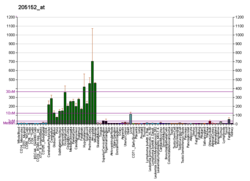GABA transporter 1 (GAT1) also known as sodium- and chloride-dependent GABA transporter 1 is a protein that in humans is encoded by the SLC6A1 gene and belongs to the solute carrier 6 (SLC6) family of transporters.[5][6][7] It mediates gamma-aminobutyric acid's translocation from the extracellular to intracellular spaces within brain tissue and the central nervous system as a whole.[8][9]
- ^ a b c GRCh38: Ensembl release 89: ENSG00000157103 – Ensembl, May 2017
- ^ a b c GRCm38: Ensembl release 89: ENSMUSG00000030310 – Ensembl, May 2017
- ^ "Human PubMed Reference:". National Center for Biotechnology Information, U.S. National Library of Medicine.
- ^ "Mouse PubMed Reference:". National Center for Biotechnology Information, U.S. National Library of Medicine.
- ^ Huang F, Shi LJ, Heng HH, Fei J, Guo LH (September 1995). "Assignment of the human GABA transporter gene (GABATHG) locus to chromosome 3p24-p25". Genomics. 29 (1): 302–304. doi:10.1006/geno.1995.1253. PMID 8530094.
- ^ "Entrez Gene: SLC6A1 solute carrier family 6 (neurotransmitter transporter, GABA), member 1".
- ^ Scimemi, A (2014). "Structure, function, and plasticity of GABA transporters". Frontiers in Cellular Neuroscience. 8: 161. doi:10.3389/fncel.2014.00161. PMC 4060055. PMID 24987330.
- ^ Gonzalez-Burgos G (2010). "GABA transporter GAT1: a crucial determinant of GABAB receptor activation in cortical circuits?". GABABReceptor Pharmacology - A Tribute to Norman Bowery. Advances in Pharmacology. Vol. 58. pp. 175–204. doi:10.1016/S1054-3589(10)58008-6. ISBN 9780123786470. PMID 20655483.
- ^ Johannesen KM, Gardella E, Linnankivi T, Courage C, de Saint Martin A, Lehesjoki AE, et al. (February 2018). "Defining the phenotypic spectrum of SLC6A1 mutations". Epilepsia. 59 (2): 389–402. doi:10.1111/epi.13986. PMC 5912688. PMID 29315614.




